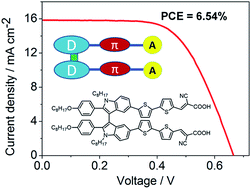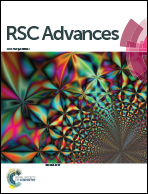Biindole-based double D–π–A branched organic dyes for efficient dye-sensitized solar cells†
Abstract
A novel class of double D–π–A branched organic dyes based on 2,2′-disubstituted-1H,1′H-3,3′-biindole moiety have been synthesized, characterized and applied as photosensitizers for dye-sensitized solar cells. Their photophysical, electrochemical and photovoltaic properties are further investigated. These type of organic dyes contain two cyanoacrylic acid moieties as electron acceptors/anchoring groups and different electron-rich conjugated linkers such as furan (JY11), thiophene (JY12) and 2,2′-bithiophene (JY13) as π-bridges. The superiority of the cross X-shaped structure of these double D–π–A branched organic dyes is the suppression of the intermolecular interactions and the guarantee of fast electron injection into the TiO2 semiconductor in the dye-sensitized solar cells. A highest power conversion efficiency of 6.54% was achieved for JY13-based cell with an iodine electrolyte under simulated AM 1.5 G solar irradiation (100 mW cm−2).


 Please wait while we load your content...
Please wait while we load your content...